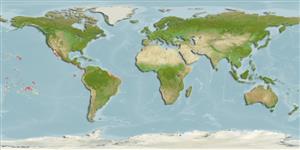Common names from other countries
Environment: milieu / climate zone / depth range / distribution range
Ecologie
; zoetwater; brakwater. Tropical
Pacific and Atlantic: South and Central America.
Length at first maturity / Size / Gewicht / Leeftijd
Maturity: Lm ? range ? - ? cm Max length : 23.0 cm TL mannelijk/geslacht niet bekend; (Ref. 86255)
Adults range from 15 to 23 cm in length. This species has a bufotoxin that is a defense mechanism for marine toads. This causes irritation to humans and animals especially when in contact with the eyes and other mucous membranes (Ref. 86255). This is an omnivorous species. Its diet is composed of insects like beetles, ants, and earwigs, vegetation, small birds, other amphibians like toads, frogs, lizards, small mammals and snakes (Ref. 86255).
Life cycle and mating behavior
Geslachtsrijpheid | Voortplanting | Kuitschieten | Eieren | Fecundity | Larven
Mating season is during spring, particularly late March. Breeding is from April to September wherein two strings of eggs are released by the female on the water surface. It takes 3 days before hatching occurs. From small tadpoles, they metamorphose to small toads in 45 to 50 days.
Integrated Taxonomic Information System. 2003. (Ref. 538)
Status op de Rode Lijst van het IUCN (Ref. 130435)
Status bij CITES (Ref. 108899)
Not Evaluated
Not Evaluated
Gevaarlijk voor mensen
Other
Gebruik door de mens
| FishSource |
Tools
Meer informatie
Leeftijd/GrootteGroeiLengte-gewicht parametersLengte-lengte parametersMorfologieLarvenAbundantie
Internet-bronnen
Estimates based on models
Preferred temperature
(Ref.
115969): 24.2 - 29.1, mean 27.7 (based on 264 cells).
